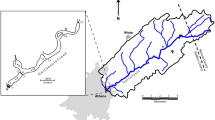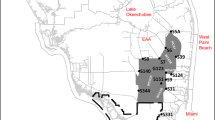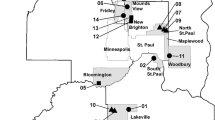Abstract
A combination of toxicity tests, chemical analyses, andToxicity Identification Evaluations (TIEs) were used toinvestigate receiving water toxicity in the Calleguas Creekwatershed of southern California. Studies were conductedfrom 1995 through 1999 at various sites to investigatecauses of temporal variability of toxicity throughout thissystem. Causes of receiving water toxicity varied by siteand species tested. Investigations in the lower watershed(Revolon Slough, Santa Clara Drain, Beardsley Wash)indicated that toxicity of samples to the cladoceran Ceriodaphnia dubia due to elevated concentrations ofthe organophosphate pesticide chlorpyrifos, while causes ofintermittent toxicity to fathead minnows (Pimephalespromelas) and the alga Selanastrum capricornutum wereless clear. Investigations at sites in the middle and upperreaches of the watershed (Arroyo Simi and Conejo Creek)indicated that the pesticide diazinon was the probable causeof receiving water toxicity to Ceriodaphnia. Elevatedammonia was the cause of toxicity to fathead minnows in theupper watershed sites. Results of these and previousstudies suggest that biota are impacted by degraded streamquality from a variety of point and non-point pollutionsources in the Calleguas Creek watershed. Water qualityresource manager's efforts to identify contaminant inputsand implement source control will be improved with thefindings of this study.
Similar content being viewed by others
References
Anderson, B. S., Hunt, B. M., Phillips, S., Newman, J., Tjeerdema, R. S., Fairey, R., Oakden, J., Wilson, C. J., Kapahi, G., Stephenson, M. D., Puckett, Lyons, M. and Birosik, S.: 1998, 'Chemistry, Toxicity and Benthic Community Conditions in Selected Sediments of the Los Angeles Region', Final Report, State Water Resources Control Board, Sacramento California. pp 232.
Ankley, G. T., Dierkes, J. R., Jensen, D. A. and Peterson, G. S.: 1991, 'Piperonyl butoxide as a tool in aquatic toxicological research with organophosphate insecticides', Ecotoxicol. Environ. Saf. 21, 266–274.
Bailey, H. C., Deanovic, L. A., Reyes, E., Kimball, T., Larson. K., Cortright, K., Connor, V. and Hinton, D. E.: 2000, 'Diazinon and chlorpyrifos in urban waterways in Northern California, USA', Environ. Toxicol. Chem. 19, 82–87.
Bailey, H. C., Villalobos, A., Gottl, E., Brattin, L., Hanes, D. and Hinton, D. E.: 1996a, 'Toxicity Study of the Santa Clara River, San Gabriel River, and Calleguas Creek', Technical Report, California Regional Water Quality Control Board, Los Angeles Region, Los Angeles, CA, 90013, pp 96–114.
Bailey, H. C., DiGiorgio, C., Kroll, K., Miller, J. L., Hinton, D. E. and Starrett, G.: 1996b, 'Development of procedures for identifying pesticide toxicity in ambient waters: carbofuran, diazinon, chlorpyrifos', Environ. Toxicol. Chem. 15, 837–845.
Bailey, H. C., Miller, J. L., Miller, M. J., Wiborg, L. C., Deanovic, L. and Shed, T.: 1997, 'Joint acute toxicity of diazinon and chlorpyrifos to Ceriodaphnia dubia', Environ. Toxicol. Chem. 16, 2304–2308.
California Regional Water Quality Control Board, Los Angeles Region: 1994, Water Quality Control Plan-Los Angeles Region. Basin Plan for the Coastal Watersheds of Los Angeles and Ventura Counties.
California Regional Water Quality Control Board, Los Angeles Region: 1995, Calleguas Creek preliminary report: State of the Watershed. CRWQCB - Los Angeles, CA. 46 pp.
California State Water Resources Control Board: 1998, California 303 (d) list and TMDL priority schedule. Proposed study plan approved by U.S. EPA (May 12, 1999).
De Vlaming, V., Connor, V., DiGiorgio, C., Bailey, H. C., Deanovic, L. A. and Hinton, D. E.: 2000, 'Application of whole effluent toxicity test procedures to ambient water quality assessment', Environ. Toxicol. Chem. 19, 42–62.
U.S. Environmental Protection Agency: 1993, 'Methods for Aquatic Toxicity Identification Evaluations; Phase II Toxicity Identification Procedures for Samples Exhibiting Acute and Chronic Toxicity', EPA/600/R-92/080 Technical Report, U.S. Environmental Protection Agency, Duluth, MN.
Fairey, R., Roberts, C., Jacobi, M., Lamerdin, S, Clark, R., Downing, J., Long, E., Hunt, J., Anderson, B, Newman, J., Stephenson, M. and Wilson, C. J.: 1998, 'Assessment of sediment toxicity and chemical concentrations in the San Diego Bay region, California', Environ. Toxicol. Chem. 17(8), 1570–1581.
Fukuto, T. R.: 1987, 'Organophosphorous and Carbamate Esters: The Antichloinesterase Insecticides', in: J. Biggar and J. Seiber (eds), Fate of Pesticides in the Environment, Publication 3320, Agricultural Experimental Station, University of California, Davis, CA, USA, pp. 5–18.
Harrington, J. M.: 1998, 'Biological and Physical Habitat Assessment of California Water Bodies: Calleguas Creek Characterization Study - Benthic Macroinvertebrates', pp. 18.
Hunt, J. W., Anderson, B. S., Phillips, B. M., Tjeerdema, R. S., Taberski, K. M., Wilson, C. J., Puckett, H. M., Stephenson, M., Fairey, R. and Oakden, J.: 2001, 'A large-scale categorization of sites in San Francisco Bay based on the sediment quality triad, toxicity identification evaluations, and gradient studies', Environ. Toxicol. Chem. 20, 1252–1265.
Markle, P. J., Gully, J. R., Baird, R. B., Nakada, K. M. and Bottomley, J. P.: 2000, 'Effects of several variables on whole effluent toxicity test performance and interpretation', Environ. Toxocol. Chem. 19, 123–132.
Mount, D. I. and Anderson-Carnahan, L.: 1988, 'Methods for Aquatic Toxicity Identification Evaluations: Phase I Toxicity Characterization Procedures', EPA/600/3-88/034 Technical Report, U. S. Environmental Protection Agency, Duluth, MN.
Oris, J. T., Winner, R. W. and Moore, M. V.: 1991, 'A four-day survival and reproduction test for Ceriodaphnia dubia', Environ. Toxicol. Chem. 10, 217–224.
Rasmussen, D.: 1995, 'Toxic Substances Monitoring Program: 1992-1993 Draft Report', Publication No. 95-1 WQ, State Water Resources Control Board, California Environmental Protection Agency, Sacramento, CA, U.S.A.
U.S. Environmental Protection Agency: 1991, Phase I Toxicity Characterization Procedures, Second Edition. EPA/600/6-91/003.
U.S. Environmental Protection Agency: 1994, 'Short-term Methods for Estimating the Chronic Toxicity of Effluents and Receiving Water to Freshwater and Marine Organisms', 4th ed., EPA 600/4-90/027. Technical Report, Washington, DC.
U.S. Environmental Protection Agency: 1995, Office of Pesticide Programs, Environmental Effects Database (EEDB), Environmantal Fate and Effects Division, U.S. EPA, Washington, DC.
Walker, L.: 2000, Calleguas Creek Characterization Study: Results of the Coordinated Water Quality Monitoring Program, Surface Water Element. L. Walker and Associates, Thousand Oaks, CA 91360.
Author information
Authors and Affiliations
Corresponding author
Rights and permissions
About this article
Cite this article
Anderson, B.S., de Vlaming, V., Larsen, K. et al. Causes of Ambient Toxicity in the Calleguas Creek Watershed of Southern California. Environ Monit Assess 78, 131–151 (2002). https://doi.org/10.1023/A:1016359617129
Issue Date:
DOI: https://doi.org/10.1023/A:1016359617129




